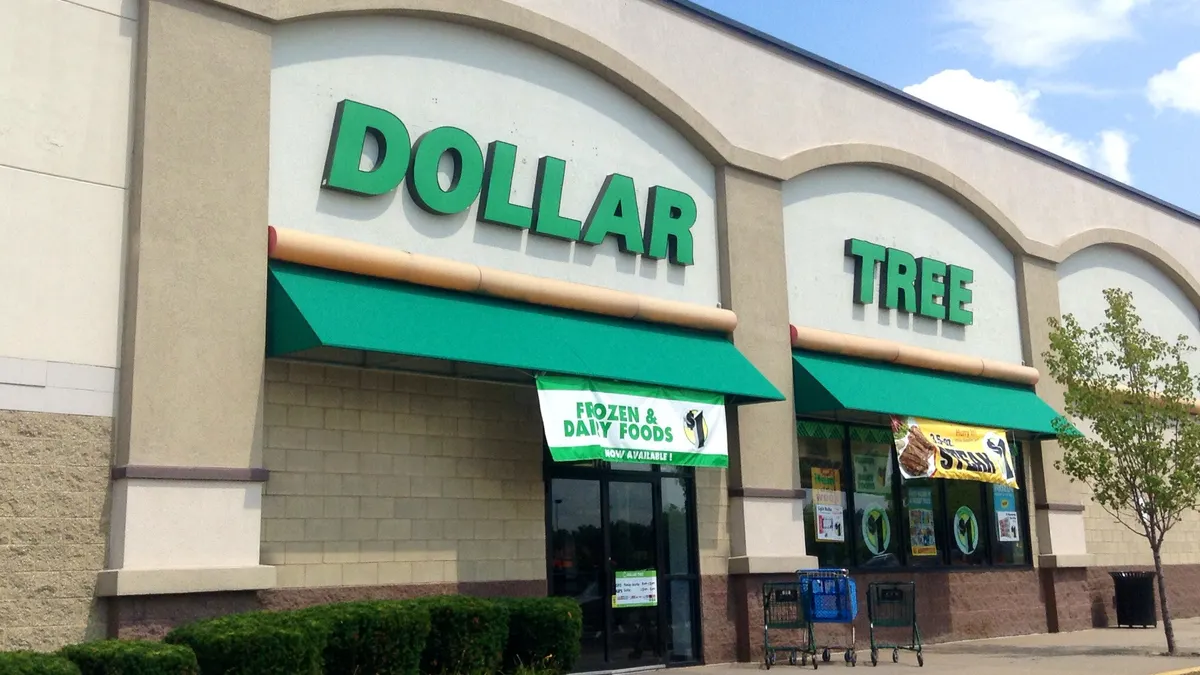Dive Brief:
-
Dollar Tree on Tuesday reported that third quarter consolidated net sales rose 6.3% to $5.32 billion from $5 billion in the prior year’s third quarter, beating the Zacks consensus estimate of $5.28 billion.
-
Same-store sales in the quarter rose 3.2%, driven by increases in average ticket and comparable transaction count, with its Dollar Tree banner same-store sales rising 5% and Family Dollar same-store sales rising 1.5%, according to a company press release. The Family Dollar performance missed Jeffries analyst expectations, according to a note emailed to Retail Dive.
-
Gross profit rose 9.6% to $1.67 billion from $1.52 billion in the prior year’s third quarter, increasing as a percentage of sales to 31.3% from 30.4% in the prior year. The 90 basis point improvement was the result of lower merchandise costs, markdowns and occupancy costs as a percentage of sales, the company said. Selling, general and administrative expenses were 23.3% of sales down from 23.6% of sales a year ago.
Dive Insight:
Fierce price competition in retail is helping dollar stores, and that looks likely to continue. While Dollar Tree is working to attract sales from higher-income customers, it’s staying focused on those with tighter budgets, executives told analysts in a conference call Tuesday, according to a transcript from Seeking Alpha.
"There’s a customer that’s still is under pressure," CEO Gary Philbin told analysts. "Rents continue to rise. Healthcare continues to rise. We have to be right on when they have money in their pocket we call it thrive and survive. So certainly, at the beginning of the month for our most needy customers we need to be ready in store with the basics. So, we got to stay focused on that customer who might have a little more jingle in their pocket but we have got to be grounded on everyday great retails and they got to have confidence that we are in stock with them in store."
It’s a segment of retail that is performing well, and Dollar Tree, unlike many retailers these days, is opening more store than it’s closing, with little emphasis on e-commerce. During the quarter, the company opened 169 stores, expanded or relocated 23 and closed six. Retail selling square footage at quarter end was some 115.8 million square feet, the company said.
"Dollar Tree’s better than expected quarterly results demonstrate the popularity of the value segment among consumers and is evidence that not all retail segments are hurting," Moody’s Vice President Mickey Chadha said in an email to Retail Dive. "The company’s total same store sales growth of 3.2% with growth recorded in both the Dollar Tree and the Family Dollar banners accompanied by a 90 basis point improvement in gross margin for the quarter is impressive particularly in a challenging retail environment."
Given the company's broad assortment and low prices, the chain will continue to outperform, Chadha also said.
But Family Dollar is vulnerable, as apparent in its smaller same-store sales performance, and is not delivering discounts expected of dollar stores, Jeffries warned. "[P]rice investments remain more limited," according to a Jeffries note emailed to Retail Dive. "Our pricing work has shown that price gaps with [Dollar General] remain wider than they should and are the widest we have seen with [Walmart]."
Dollar Tree (and its Family Dollar stores) is benefiting from its format and locations, which are smaller and more urban than big-box stores like Walmart and Target, noted Philbin. "We have more stores in urban America than anyone else," he told analysts. "I think it speaks to us knowing our customer better than anyone else in the arenas that we compete in….I think both Dollar Tree and Family Dollar we are a company that’s going to grow hundreds of stores each year when other retailers are potentially pulling back."
Chadha also flagged that as a strength for the company. "We believe Dollar Tree benefits from its convenient smaller shopping locations which makes the stores faster to shop than the larger format of other discounters," he said.
That’s driving loyalty, too, according to GlobalData Retail Managing Director Neil Saunders. "It is notable that many of the group's core customers have seen their financial positions improve modestly over the course of this year, yet their loyalty and share of spending at both Dollar Tree and Family Dollar have largely remained the same or increased," he said in an email to Retail Dive. "One of the main reasons for this is that they like the convenience and localness of the stores in addition to the low prices they offer."
It’s not just prices, either, Saunders said — convenience is also getting people into Dollar Tree and Family Dollar stores, and that’s often overlooked as a strength. "For many consumers, including more affluent shoppers, it is a critical differentiator," he noted. "This is one of the reasons why Dollar Tree sees the potential for many more U.S. stores (up to 10,000 Dollar Tree outlets and 15,000 Family Dollar shops)."
That may be overly optimistic, though, Saunders warned. All in all, Dollar Tree is in a good position, especially as the company continues to realize the benefits of its Family Dollar acquisition. "While the sales line looks strong, the bottom line is also benefiting from cost savings and continued synergies from the integration of Family Dollar," Saunders said. "With net income up by 39.8% this quarter and with strong cash flow, Dollar Tree is delivering good returns and, in our view, will continue to do so."













